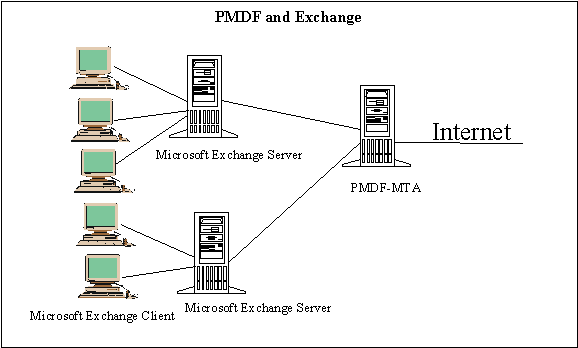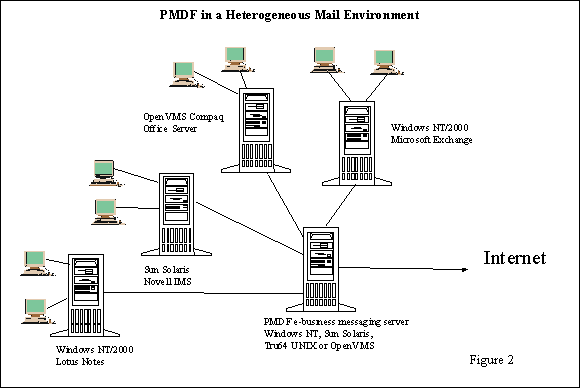Messaging Backbone: PMDF vs. Exchange
A messaging backbone is responsible for receiving, storing, routing, and delivering messages within an enterprise or to remote sites via the Internet. Some of the criteria for choosing an enterprise messaging backbone system are:
- It must be secure
- It must have the ability to process, manage, and troubleshoot large amounts of mail
- It should inter-operate with other message systems
- It must be reliable
Exchange does not meet these criteria and is better suited for presenting mail to the user after the mail has been processed by a messaging backbone. An enterprise can benefit from a powerful secure messaging backbone such as PMDF, and the user friendly features in Exchange such as calendaring (Figure 1) by using the products in conjunction with each other.

Exchange does NOT support the following features that are critical to an enterprise messaging backbone:
- Filter by file type to prevent the spread of viruses. Executable files often transmit viruses. With PMDF, a system administrator can filter executable files via the conversion channel and perform any of the following options:
- Delete all executable files automatically
- Replace the file with a text message alerting the user that the file was deleted
- Use virus scanning software automatically prior to the delivery of mail
- Filter on key words to prevent spam or the spread of viruses.
- A system administrator can proactively search and isolate messages based on key words or header information. For example, a search can be done on "make money" or on the From: field. These messages can be filtered to prevent spam, creating a more secure messaging system.
- A system administrator can identify key words used in a virus and filter the message. For example, with the Melissa virus, "Melissa" was in the name of the file. The system administrator could filter out all files based on the word Melissa. Exchange, in combination with client anti-virus software, filters the virus eventually. However, it took some additional time for anti-virus software companies to develop a solution. System administrators also have to depend on the users to download and install the anti-virus software on their own systems. PMDF administrators filtered for "Melissa" and stopped delivery before it reached the users.
- Provides secure communication with SASL, CRAM-MD5 and DIGEST-MD5. PMDF includes additional security methods such as authentication with SASL, CRAM-MD5 and DIGEST-MD5. SASL is a method for adding authentication support to POP or IMAP logins and to SMTP message submissions. PMDF comes with built-in CRAM-MD5 and DIGEST-MD5 authentication methods to avoid the clear text transmission of users and passwords during logins.
- Filter by file type to avoid consuming bandwidth. Some application files (such as BMP, JPG and MP-3) are bandwidth intensive and often not related to work. The single message parts can be deleted automatically that have these files or can be substituted with a text notification part. The system administrator can develop system level filters using the SIEVE mail filtering language. Exchange does not support SIEVE.
- Troubleshooting from a command line interface allows you to save time by isolating problems faster. Exchange mail messages are stored in one large database that is accessed with a GUI interface, which is difficult to manage. With the release of Exchange 2000, this database can be broken up into separate databases to improve performance and make it more manageable. However, Exchange is still difficult to manage because a system administrator must point and click, selecting one message at a time to examine causes for a delay in a queue. Additionally, there is no means of examining every aspect of the processing of an e-mail address. With PMDF, a system administrator can easily examine all steps in this process at the operating level in order to diagnose problems.
- Logging and testing utilities save time by:
- Isolating problems faster
- Monitoring performance proactively for capacity planning
- Providing granular control over your system configuration
PMDF logs every action that takes place during mail processing. These extensive log files allow a system administrator to analyze and isolate where a problem may reside. System administrators can customize the level of detail they want to track.
PMDF can monitor the overall health of a network by measuring loopback messages. PMDF can send out a message to the remote system and have it loop back to its origin. The outbound and the arrival of an inbound message can be analyzed for performance. Also, mail monitoring is available through the Mail Monitoring MIB, RFC 1566.
Finally, a system administrator can test configuration changes or new installations locally before they are implemented globally. In this way, potential problems can be identified prior to deployment.
- Mailing list management saves time. PMDF includes basic mailing list management tools that Exchange does not provide. For example, PMDF permits users to control mailing lists similar to those of majordomo and LISTSERV.
- Support for Internet standards for better interoperability with other mail systems. PMDF supports IETF standards including SMTP, SMTP extensions, and MIME protocols that are needed for communicating over the Internet. Exchange has many incomplete and poor implementations of these standards. PMDF provides more advanced flexibility for setting up your Internet connectivity, with multiple domain support, better relay security, black-list and white-list support, and many features not available in any version of Exchange.
- Provides integration of disparate directories for investment protection. Although a directory is not required for the operation of a PMDF messaging backbone, PMDF provides access to any X.500 and LDAPv3 (Lightweight Directory Access Protocol) compliant directories. For the organizations that have not standardized on one directory type, PMDF offers a fully automated, highly customizable solution for synchronizing data contained in multiple disparate directories. Exchange only supports Active Directory.
- PMDF runs on several different platforms. Unlike Exchange, which runs only on Windows, PMDF has a long history of running on multiple operating systems including OpenVMS and Linux.

- Proven reliability and outstanding customer support. PMDF has been an industry leading messaging backbone for thirteen years. It was developed using industry standards by engineers who helped formulate those standards. PMDF is reliable, stable and the technical support is second to none for messaging products. Exchange is still evolving, so every version of Exchange has a significant time of questionable stability while bugs are addressed. Service Packs (bug fixes) address the major issues, but they are released irregularly.
PMDF satisfies the criteria outlined above for a reliable enterprise mail backbone:
PMDF:
- Is secure
- Processes, manages, and troubleshoots large amounts of mail
- Inter-operates with other message systems
- Is reliable
Exchange does not meet these criteria; it is better suited as a departmental mail server. The two products used in conjunction with each other provide optimized security, performance, and reliability with PMDF and user friendly features with Exchange.